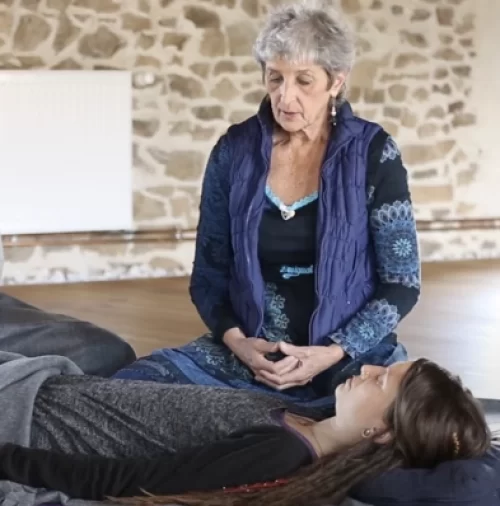CONSCIOUS BREATHING FOR TRAUMA RECOVERY (CBTR)
Free online conscious breathing education that is both simple and effective

The CBTR training has been created by Brigitte Martin Powell and Judee Gee, breath specialists and breathwork trainers based in the UK and in France. Judee and Brigitte are former Presidents of the IBF. At the time of developing this programme they were sitting on the IBF-UN working group committee which develops Conscious Breathing projects in alignment with the United Nations 2030 Agenda for Sustainable Development.
The CBTR programme was originally designed for refugees, migrants and victims of natural disasters as well as health care workers, staff and volunteers of relief organisations.
It has been now extended to include anyone suffering from trauma, anxiety, burnout and depression.
The goal of the CBTR programme is to provide free online conscious breathing education that is both simple and effective through:
- Giving practical instructions for developing an awareness of current breathing habits
- Teaching specific breathing exercises to recalibrate the autonomic nervous system
What is coherent breathing
Coherent Breathing and the Autonomic Nervous System
Un componente importante del sistema de respuesta al estrés es el sistema nervioso autónomo, que gestiona las funciones automáticas del cuerpo, incluyendo los sistemas cardiovascular, respiratorio, digestivo, hormonal, glandular e inmunológico. El sistema nervioso autónomo tiene dos ramas principales: el sistema nervioso simpático – el sistema de lucha o vuelo – y el sistema nervioso parasimpático – el resto y digerir o alimentar y reproducir– sistema.
Idealmente, ambos sistemas están obligados a intervenir para acciones específicas a lo largo de nuestra vida diaria, pero a largo plazo es necesario un equilibrio entre los dos. Un cuerpo que está constantemente bajo estrés mental, físico o emocional (sistema simpático) sin tiempo para descansar, integrarse y reponer (sistema parasimpático), no será capaz de funcionar de manera óptima y sufrirá las consecuencias.

There is one automatic function of the body that can be voluntarily controlled through our breath and that is the respiratory system! Las técnicas de respiración consciente proporcionan un fácil acceso a la red de comunicación autonómica y al cambiar nuestros patrones respiratorios, enviamos mensajes específicos al cerebro que tienen efectos poderosos en nuestros pensamientos, emociones y comportamientos. Por ejemplo, cuando nos sentimos ansiosos, sólo unos minutos de Respiración Coherente pueden calmar nuestra mente preocupada y fomentar una toma de decisiones más racional -en lugar de impulsiva-.
Práctica de respiración coherente: Respirar al ritmo de 5 respiraciones por minuto es el ritmo respiratorio óptimo para reequilibrar el cuerpo y acceder a un estado interior de relajación que es a la vez pacífico y tranquilo. Cinco respiraciones por minuto corresponden a la respiración durante 6 segundos y hacia fuera durante 6 segundos, uniendo la respiración y la salida de una manera relajada.
Cómo practicar: Comienza progresivamente, respiraconscientemente y de una manera relajada durante 3 segundos y 3 segundos, hasta que se sienta cómodo. A continuación, pasar a la respiración durante 4 segundos de entrada y 4 segundos hacia fuera y progresar a su propio ritmo hasta 6 segundos de entrada y 6 segundos fuera. La gente más alta podría querer respirar más lentamente.
Dónde practicar: Comience por encontrar un lugar tranquilo donde pueda estar tranquilo durante varios minutos. Las condiciones de luz suave o la oscuridad le ayudarán a relajarse. Tenga una manta ligera a mano para asegurarse de mantenerse caliente. Siéntese o acuéstese en una posición cómoda y comience su práctica. Una vez que te sientas cómodo con la práctica podrás aplicarla en una amplia gama de situaciones (sentado, caminando…).
Cuándo practicar: Tres veces al día durante cinco minutos (365) es un gran comienzo, y si puedes aplicar la práctica diariamente durante unas semanas, cosecharás la mayoría de los beneficios. Incluso un minuto de respiración coherente ayudará a reequilibrar su sistema nervioso. Stephen Elliot sugiere 20 minutos por día durante un período de 21 días con el fin de recalibrar el sistema nervioso e instalar el reflejo de respiración coherente como una práctica predeterminada.
The CBTR training has been created by Brigitte Martin Powell and Judee Gee, breath specialists and breathwork trainers based in the UK and in France. Judee and Brigitte are former Presidents of the IBF. At the time of developing this programme they were sitting on the IBF-UN working group committee which develops Conscious Breathing projects in alignment with the United Nations 2030 Agenda for Sustainable Development.
CBTR VIDEOS
Watch the trailer:
Watch the Presentation:
Watch the Demonstration:
Credits
Thanks to the IBF Development Fund for funding the development of the CBTR training programme in Athens, Greece.
THE CBTR MANUALS
THE IBF BREATHING APP
This free app is the perfect tool to practice the CBTR Program – and much more.
It is now available for free for iPhones on the Apple Store and for Androids on the Google Play Store. The name of the app is IBF Breathing App.
If you want to get more detailed information about the IBF Breathing app, click here:

For more information about Coherent Breathing
Keywords for Internet search
Respiración consciente
Respiración
Coherent Breathing
Stephen Elliott
Sympathetic and Parasympathetic Nervous System
Heart Rate Variability (HRV)
Renuncia
This presentation is designed to provide helpful guidance for recovering from trauma and reinforcing natural resiliency, but should not be used to diagnose or treat any health or medical conditions requiring medical supervision.
The publisher and authors are not liable for any consequences from the application by any person using the information provided in the presentation. Even though conscious breathing is simple and safe, some may find this method challenging, and are encouraged to consult a conscious breathing specialist in order to progress in the practice.